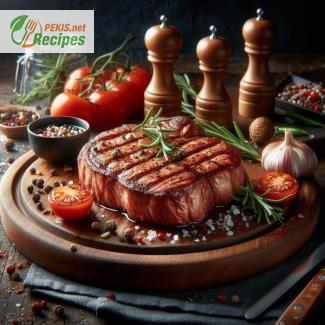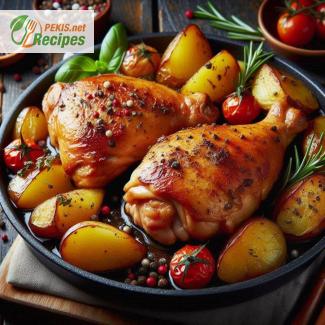
The best recipe for juicy steaks is more than just a method; it's a culinary journey that combines the right cut of meat, proper seasoning, and expert cooking techniques to create a mouthwatering experience. At the heart of this recipe is the selection of the steak itself. Choosing a cut with marbling—those delicate streaks of fat woven through the meat—is essential for achieving maximum flavor and tenderness. Cuts like ribeye, T-bone, or filet mignon are prime candidates, as their natural fat content melts during cooking, keeping the steak moist and enhancing its richness.
Preparation starts long before the steak hits the pan or grill. One of the secrets to a perfect steak is allowing the meat to reach room temperature before cooking. This simple step ensures even cooking throughout, preventing the outside from being overcooked while the inside remains underdone. Letting the steak sit for about 30 to 60 minutes outside the fridge allows it to come to the ideal temperature, which is especially crucial for thicker cuts.
Seasoning is another crucial step in the process. While some purists argue that high-quality steak needs nothing more than a sprinkle of coarse salt and freshly cracked black pepper, a good marinade can elevate the flavors to new heights. A blend of olive oil, garlic, fresh rosemary, and a splash of lemon juice can infuse the steak with subtle layers of flavor, tenderizing the meat while adding complexity. Marinading for even a short time—15 to 30 minutes—can significantly improve the final result. If time allows, marinating for a few hours, or even overnight, can make the steak incredibly succulent and flavorful.
When it comes to cooking, temperature control is key. Searing the steak at high heat is the most effective way to lock in juices and create that highly desired caramelized crust. This Maillard reaction, where proteins and sugars in the meat react to heat, forms a deliciously crispy outer layer that enhances both texture and taste. Depending on personal preference, steaks can be cooked to varying levels of doneness—rare, medium, or well-done—but for the juiciest results, medium-rare is often considered the sweet spot. A hot skillet or grill will give the steak a quick sear, about 3-4 minutes per side for medium-rare, allowing the inside to stay tender and moist.
After cooking, many make the mistake of cutting into the steak too soon. However, resting the meat is just as important as any other step in the process. Allowing the steak to rest for 5-10 minutes after cooking lets the juices redistribute throughout the meat, ensuring each bite is as juicy as possible. Covering the steak loosely with foil helps retain heat during this crucial rest period.
The finishing touch to the perfect steak can be a small knob of butter placed on top while it rests. As the butter melts, it adds a luscious richness, complementing the natural flavors of the meat. A light sprinkle of sea salt or freshly ground pepper right before serving can also enhance the taste.
Juicy steaks aren’t just about technique; they’re about balance. The tenderness of the meat, the slight crispiness of the seared edges, and the burst of flavor in each bite come together to create an unforgettable dining experience. Whether served with a classic red wine reduction sauce or a simple side of roasted vegetables, a perfectly cooked steak is a testament to the power of simplicity and precision in cooking.
In conclusion, the best recipe for juicy steaks lies in understanding the delicate interplay between heat, seasoning, and timing. From the moment the steak is chosen to the final bite, each step is designed to enhance its natural flavors and textures, making it a dish that satisfies not only the appetite but also the senses. A well-prepared steak is more than just a meal—it’s a culinary celebration of one of the finest cuts of meat, cooked to perfection.
Best Recipe for Juicy Steaks
1. Temper the steaks:
Take the steaks out of the fridge at least 30 minutes before cooking to bring them to room temperature. This allows for even cooking and prevents the outside from overcooking while the inside stays cold.
2. Marinate the steaks:
In a bowl, mix olive oil, minced garlic, rosemary, lemon juice, salt, and pepper. Rub this mixture all over the steaks and let them sit for at least 15–20 minutes. If you have time, let the steaks marinate in the fridge for up to 4 hours to enhance flavor and tenderness.
3. Cooking the steaks:
Heat a skillet or grill to high heat. Once it's hot (almost smoking), place the steaks in the pan. Sear the steaks for 3–4 minutes on each side for a medium-rare doneness. Adjust the time based on your preferred doneness (for medium, cook 4–5 minutes per side; for well-done, 6–7 minutes). Be careful not to flip the steaks too frequently as this can affect the searing.
4. Rest the steaks:
Once the steaks are cooked, remove them from the heat and let them rest on a cutting board for 5–10 minutes. Cover them loosely with aluminum foil. Resting is crucial as it allows the juices to redistribute throughout the meat, ensuring maximum juiciness.
5. Finish with butter:
While the steaks are resting, place a small knob of butter on top of each steak. The heat from the steaks will melt the butter, adding an extra layer of richness and enhancing the flavor.
6. Serve and enjoy:
Serve the steaks with your favorite side dishes, such as roasted vegetables, mashed potatoes, or a fresh salad.
The nutritional values in this meal, consisting of steak and related ingredients, offer various health benefits, each playing an important role in supporting bodily functions and overall wellness. Here’s a detailed breakdown of how these nutrients affect our body and health:
Calories (450–500 kcal per serving):
Calories provide the energy needed for all bodily functions, from basic metabolic processes like breathing and digestion to physical activities. A serving of steak supplies a moderate amount of calories, helping to meet daily energy requirements. It is essential to consume an appropriate number of calories to maintain a healthy weight and avoid energy imbalances that could lead to weight gain or loss.
Protein (30–35g per serving):
Protein is crucial for muscle growth, tissue repair, and the production of enzymes and hormones. Steak is an excellent source of high-quality protein, containing all the essential amino acids our body needs. Consuming adequate protein helps support muscle recovery after exercise, strengthens the immune system, and promotes overall cell health. It’s particularly beneficial for active individuals and those looking to maintain or build muscle mass.
Fat (25–30g per serving, including monounsaturated and saturated fats):
Fats are necessary for numerous functions in the body, including the absorption of fat-soluble vitamins (A, D, E, and K), protection of organs, and energy storage. The fat content in this meal comes from both healthy monounsaturated fats, primarily from olive oil, and a small amount of saturated fats from butter and the steak. Monounsaturated fats are heart-healthy and can help reduce bad cholesterol levels (LDL), thus lowering the risk of heart disease. However, it’s important to keep saturated fats in moderate amounts, as excessive intake may increase LDL cholesterol and raise the risk of cardiovascular issues. In this balanced meal, the fat content contributes to satiety and flavor while providing important nutrients.
Carbohydrates (minimal, ~1-2g per serving):
This meal contains very few carbohydrates, making it suitable for those on low-carb or ketogenic diets. While carbohydrates are the body's primary energy source, this dish can be complemented with fiber-rich vegetables or whole grains to ensure a balanced intake of carbs, which support brain function and physical activity.
Fiber (0g per serving):
Although the steak itself contains no fiber, it’s essential to pair this meal with fiber-rich side dishes such as vegetables or whole grains to support digestion, promote healthy gut bacteria, and prevent constipation. Fiber also helps regulate blood sugar levels and can reduce cholesterol.
Vitamins:
- Vitamin B12 (~2.5 mcg):
Vitamin B12 is vital for the production of red blood cells and proper functioning of the nervous system. It also plays a key role in DNA synthesis. A deficiency in B12 can lead to anemia, fatigue, and neurological problems. As a natural source of this vitamin, steak helps maintain healthy energy levels and cognitive function, especially in individuals who may lack sufficient B12 intake from other sources. - Vitamin B6 (~0.5 mg):
Vitamin B6 supports protein metabolism and the production of neurotransmitters in the brain, which are essential for mood regulation and cognitive function. It also plays a role in immune health and red blood cell formation. Consuming foods rich in vitamin B6 helps maintain a healthy nervous system and supports metabolic processes.
Minerals:
- Iron (2.5–3 mg):
Iron is essential for producing hemoglobin, the protein in red blood cells responsible for transporting oxygen throughout the body. Adequate iron intake prevents iron deficiency anemia, which can cause fatigue, weakness, and impaired cognitive function. The iron found in steak is heme iron, which is more easily absorbed by the body compared to non-heme iron found in plant-based sources. - Zinc (5–6 mg):
Zinc is crucial for immune function, wound healing, and DNA synthesis. It also supports cell growth and division, making it essential for skin health and the maintenance of the body's defense system. Consuming zinc-rich foods like steak helps strengthen the immune system and supports overall health. - Phosphorus (200–250 mg):
Phosphorus is important for maintaining healthy bones and teeth, as it works alongside calcium. It also plays a role in the body's energy production by helping convert nutrients into usable energy. Phosphorus supports kidney function, muscle contractions, and nerve signaling.
Fats:
- Monounsaturated fats from olive oil:
These fats are known to support heart health by helping to reduce LDL (bad) cholesterol levels while maintaining or increasing HDL (good) cholesterol. Monounsaturated fats also provide anti-inflammatory benefits, which can lower the risk of chronic diseases such as heart disease and diabetes. - Saturated fats (moderate amounts):
Saturated fats, though necessary in small quantities for functions such as hormone production and the formation of cell membranes, should be consumed in moderation. Excessive intake may lead to higher LDL cholesterol levels and increased cardiovascular risk. In this meal, the presence of saturated fats is balanced by healthier fat sources.
Is this a healthy meal?
Yes, this meal can be considered part of a balanced and healthy diet when consumed in moderation. It provides high-quality protein, essential vitamins, and minerals that support muscle growth, red blood cell production, immune health, and overall energy metabolism. The inclusion of heart-healthy fats from olive oil adds to its nutritional profile, while the small amount of saturated fats should not pose a risk when eaten occasionally.
To enhance the nutritional benefits, pairing the steak with fiber-rich vegetables or whole grains can create a more balanced meal, providing carbohydrates and fiber that promote digestive health and sustained energy.


